The Barbados Black Belly is a hair sheep breed originating from the Caribbean island of Barbados, where it was developed in the 17th century.
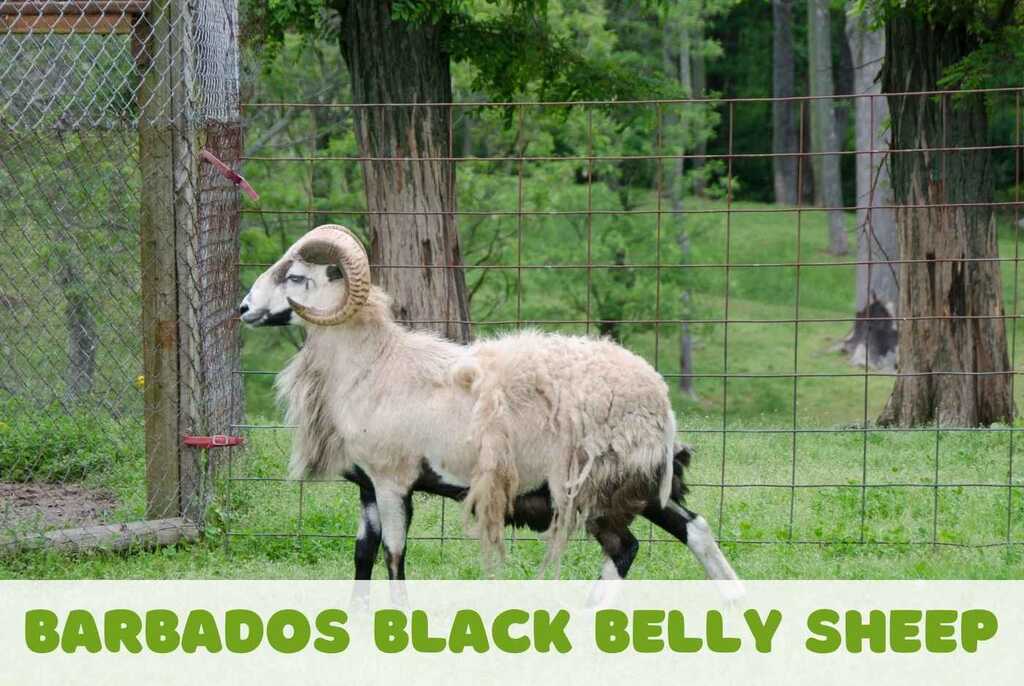
Contents
Characteristics
These sheep characteristics like color pattern and head shape make them unique among all the other existing sheep breeds.
Their appearance also sets it apart from the American Black Belly sheep, with which it is often confused.
However, the Barbados Black Belly sheep can be easily distinguished from the American variety based on physical characteristics.
The easier way to distinguish them is to check the horns.
Barbados Black Belly rams and ewes are hornless, known as polled. In contrast, American Blackbelly rams are generally horned, and whether the ewes have horns or not varies.
Size
Barbados Black Belly sheep have a medium-sized body.
An adult sheep stands between 27.5 and 31.5 inches (70 to 80 cm) tall and has a body length of 39.4 to 42.1 inches (100 to 107 cm). Keep in mind that individual variations may occur within the breed.
Color
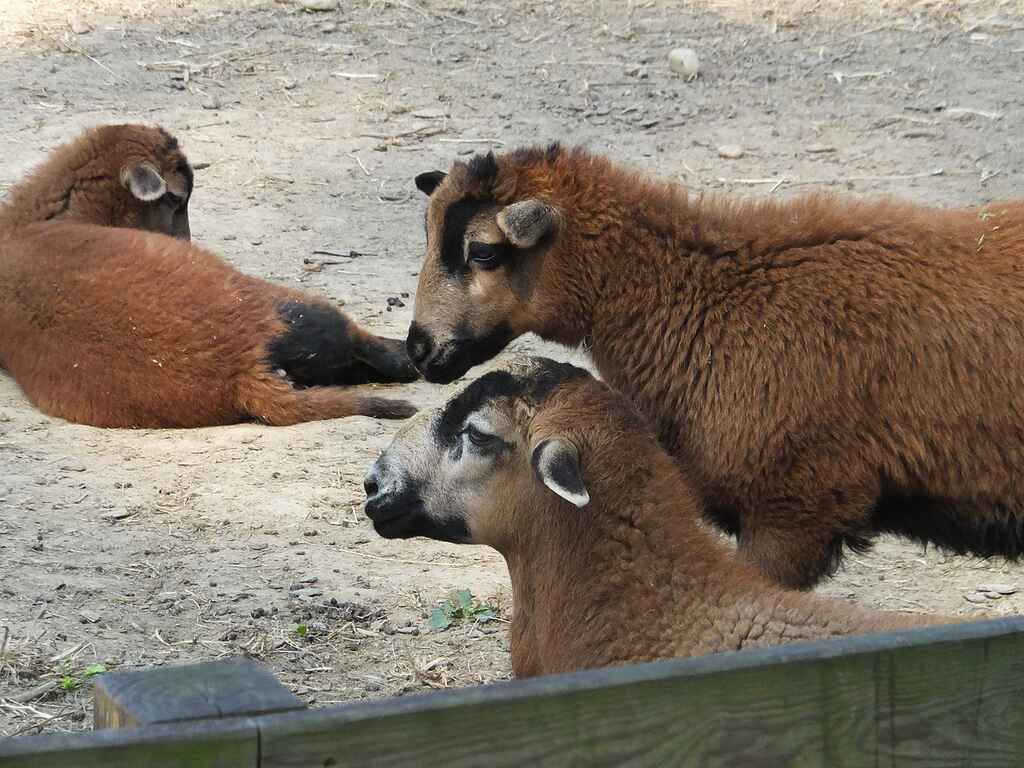
The color of these sheep can vary from light fawn, brown, to dark red. But apart from the color, they also have specific markings such as:
- A contrasting black belly that stretches down the back of the hind legs, covering the underside of the tail.
- A black top of the nose and lower jaw, as well as a black stripe down the front of the neck connecting with the black belly.
- A crown of black hair at the top of the head.
- An extra black mark extending from the outer corner of the eye to the corner of the mouth.
- A broad black mark, also known as facial bars, extends from the inner corner of each eye to the top of the head and even the mouth. In ewes, this marking is less prominent than in rams.
- Ears with a black interior.
- Black forelegs and hind legs from the knee or hock downward.
Skin
This breed of sheep has coarse hair that covers its entire body. In winter, they develop a fine woolen undercoat, which is naturally shed after the cold season.
Rams, especially mature ones, have a thicker layer of hair from the neck down to the chest compared to younger ones.
Even without long wool, these sheep have a good amount of lanolin in their hair, which helps repel water and protects them from ticks and other external parasites.
Head, Ears, Eyes
The head of this sheep has an oval to triangular shape. In rams, the head is much more masculine and slightly bigger than that of the ewes, which is also more feminine.
The muzzle is wide, the lips are firm, and the incisor teeth extend until they meet the dental pad.
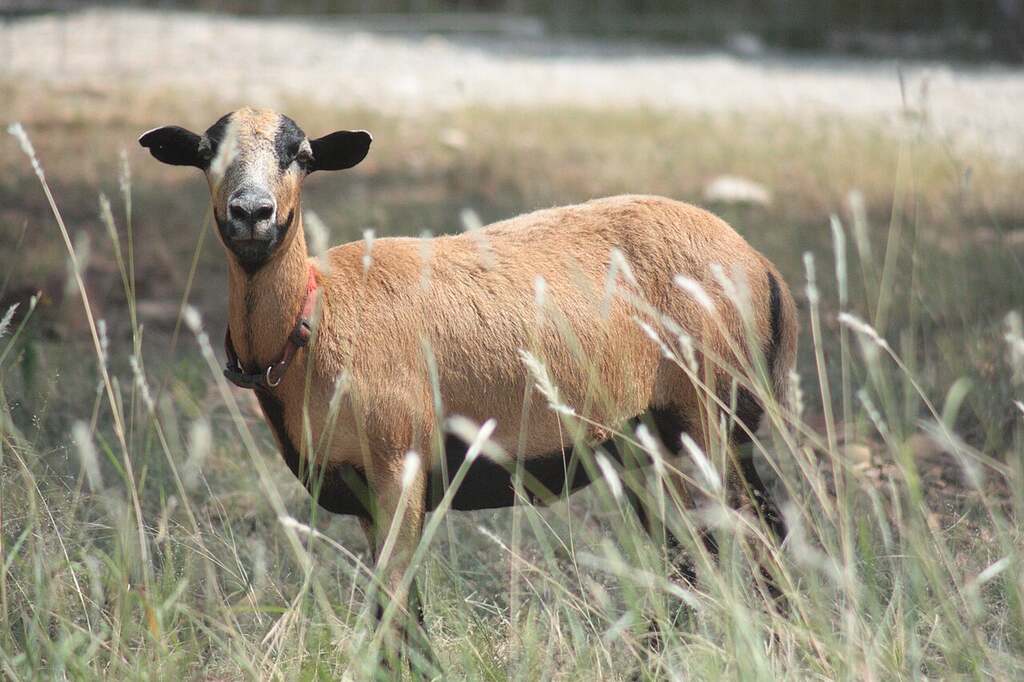
The nose features a high-set bridge, creating a rapid slant downward towards the nostrils, commonly referred to as a Roman nose.
The large ears are erect and consistently point outward from the side of the head parallel to the ground.
As for the eyes, they have an almond shape and a color that varies from brown to golden brown.
Horns
They do not have horns, and both male and female sheep possess smooth heads without any visible horn plate outgrowth.
Neck
The neck is robust, muscular, and smooth, without any loose skin folds.
Body
The body is large, deep, and wide with well-developed ribs. The neck is also incredibly robust and muscular, without any loose folds of skin.
Forequarters
They have well-developed muscles in the arms and shoulder blades. When observed from both the front and side, the forelegs appear straight.
Hindquarters
The hindquarters show defined muscles, with a long and gently sloping croup (rump).
When viewed from behind, the hind legs should appear straight. In a side view, a vertical line dropped from the rear of the buttocks should align with the point of the hock and the back of the ankle, making contact with the ground approximately 1 to 2 inches (2.5 to 5 cm) behind the heel.
Tail
The tail is long and extends to the top of the hocks.
Lifespan
The lifespan of Barbados Black Belly sheep is 10 to 13 years.
As with many other sheep and animals, factors such as living conditions, health, genetics, and diet can influence longevity.
Growth Rate
How fast do they grow?
They have a slow growth rate, reaching their final weight at 2 years old.
According to multiple studies conducted between 2000 and 2010, these sheep have one of the slowest growth rates among hair sheep breeds.
They grow faster than goats, for example, achieving a daily weight gain of 0.17 lb (0.08 kg) with a diet rich in grass hay, soybean, and cornmeal. However, their growth rate is slower than that of Katahdin and St. Croix sheep, which achieve a higher daily weight gain.
The slow growth rate is also attributed to their origins. Native to the Caribbean, they have adapted to the challenging tropical conditions and a diet of low-quality tropical forages that are high in fiber and limited in crude protein.
As for their sexual maturity, this is reached between 6 to 7 months.
Weight
Their weight is between 85 to 130 lbs (38.5 to 59 kg).
Rams are heavier than ewes, weighing 100 to 130 lbs (45 to 59 kg), while ewes weigh only 85 to 100 lbs (38.5 to 45 kg).
Besides their growth rate, these sheep’s reduced weight compared to other medium-sized sheep is also shaped by their Caribbean origins.
In response to the Caribbean climate, these sheep maintain a lower body weight to increase their heat tolerance. Also, farmers prefer smaller carcasses due to the absence of refrigeration.
Slaughtered age
You can slaughter them at 12 to 14 months, or you can wait until they reach their final weight at two years old.
It all depends on what your main aim is. If you are a homesteader who wants to enjoy the meat, then you can easily do it at 13 months to 2 years old.
But if you are in business and want to maximize profit, then you should know that lambs obtain the highest market price when they reach 12 to 14 months old.
Sheep older than 12 months receive a lower price per pound. The buyer can determine the age of the animal by examining its teeth.
Shearing
You do not need to shear them because they are a hair sheep breed.
Their coat consists of hair rather than wool, making shearing unnecessary.
Temperament and Behaviour
These sheep are docile animals with a strong flocking instinct.
They are very sociable and enjoy living in large groups. Their tendency to live in groups makes them quite independent and less reliant on constant care or attention from the farmer.
Although they are generally docile, they are often nervous and can be easily frightened by anything new in their environment, such as new people, pets, or other animals.
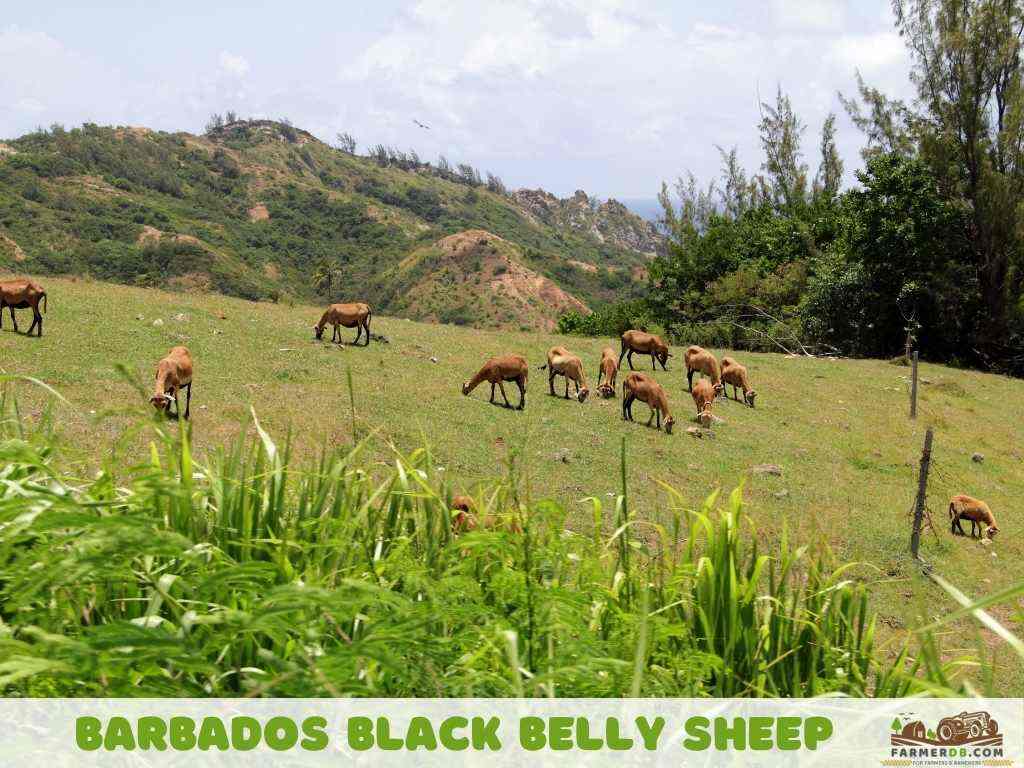
This nervous behavior is present even in newborn lambs, and it can be difficult to make them more cuddly or friendly. When raising them, keep in mind that they typically don’t enjoy petting.
Due to their weight, they are very active. They love to exercise, run, and jump over fences. Even electric fences may not stop them. Be cautious of this behavior, as once they escape, it can be difficult to catch them due to their incredible speed.
These sheep are also extremely protective of one another and are always alert for potential danger or predators.
Usage
The primary purpose of raising this breed of sheep is for meat production.
Meat
The meat of this sheep is known for its milder lamb flavor. The mildness of the meat’s lamb flavor is because the sheep has less body fat than usual, as the flavor of sheep meat is often associated with fat.
The fat over the twelfth rib of the ribeye muscle (longissimus dorsi) averages 0.06-0.08 inches (1.5-2 mm), in contrast to 0.2-0.24 inches (5-6 mm) in other sheep like Suffolk or Dorset crosses. Therefore, the meat is not only extremely lean but also incredibly tender.
Their meat can be used to prepare various dishes using methods like grilling, roasting, and even stewing.
Barbados Black Belly sheep meat is preferred by those who appreciate a lighter taste in lamb.
Raising
Feeding
These sheep are good grazers, feeding themselves with fresh grasses and shrubs. You can also feed them with:
- alfalfa hay or pellets
- whole grains
- crushed corn
- rolled oats
These sheep are low-maintenance in terms of food, making them easy to raise. They do well on various feeds, provided you supplement their diet with minerals like salt licks.
These sheep are cost-effective to raise because they require less food compared to other sheep breeds. In winter, you can feed around 8-10 sheep per day with just one small square hay bale (weighing about 50-60 lbs/22.7-27.2 kg).
If your area doesn’t have a growing season for the entire year, you’ll likely need to give them hay for at least 4 months each year
Remember to provide them with an easily accessible source of fresh water.
How many sheep per acre?
The number of sheep per acre is highly influenced by the quality of the pasture.
You can raise 8-10 sheep per acre if your pasture has a medium quality and 10-12 if your pasture is high in vegetation.
Environment
You should raise these sheep in an environment like a pasture, where they can graze, run, and expend their energy. While they can adapt to a closed environment, it is much harder to manage them due to their high energy levels.
Climate
These Caribbean-originated sheep can thrive in all kinds of climates. They develop well in hot, humid environments but also colder ones, as long as they have the right accommodations.
Shelter
You should provide shelter for them during colder temperatures. Since they have no wool, they tend to seek shelter when the weather gets chilly. The shelter should have appropriate hay bedding to keep them warm and dry.
Breeding
Breeding these sheep is very easy and does not require human intervention. These sheep naturally mate more than once per year, unlike sheep that have a specific breeding season.
You can breed them at 6 months of age but not earlier than that. These sheep are prolific, and it is very common for them to give birth to twins more than once.
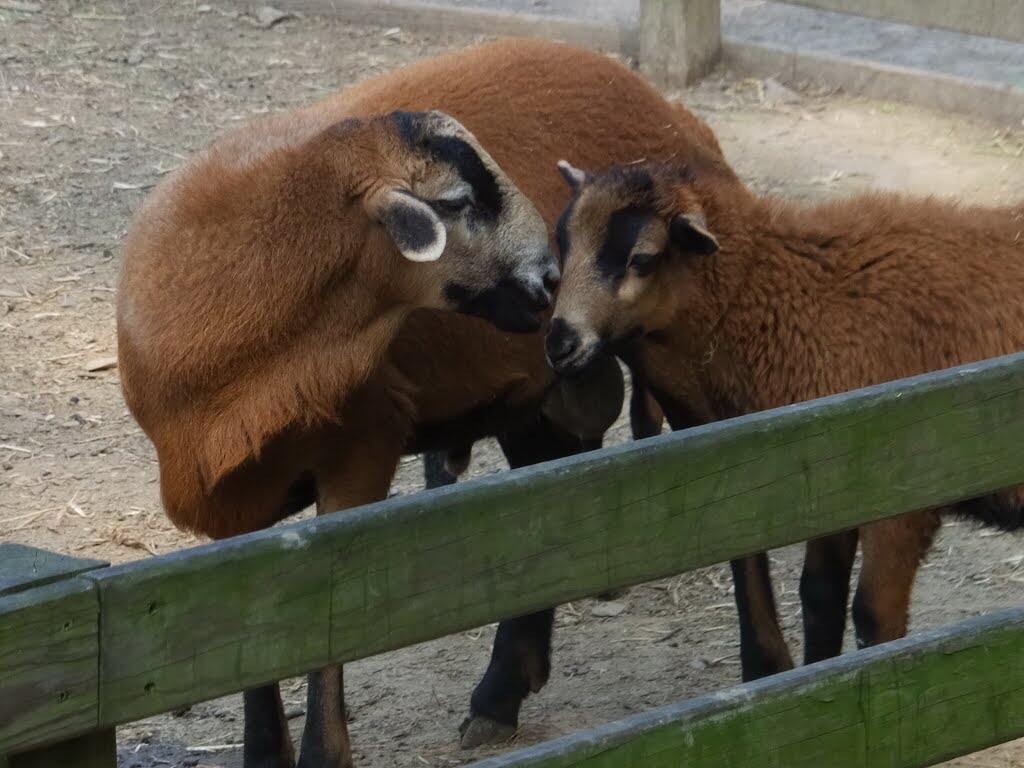
A healthy ewe can lamb every 8 months and has a gestation period of 5 months. Similar to mating, ewes also do not need any help during birth. The mortality rate is lower compared to other sheep breeds.
Ewes also have great mothering skills and produce enough milk to feed the lambs. They usually separate themselves and their lamb from the flock, preferring to take care of them in an isolated area of the shelter, far away from harsh weather conditions.
Health Issues
They are hardy animals, known for their resistance to internal parasites, such as gastrointestinal worms.
Some of the common health issues for them include:
- Overfeeding: Since they are used to eating less than other sheep, overfeeding them can cause health issues.
- Pregnancy toxemia (see refs.): Ewes carrying multiple lambs may be susceptible to pregnancy toxemia, a metabolic disorder.
- Mineral deficiencies: They need a proper diet that provides all essential minerals like selenium and copper.
Why should you raise them?
Barbados Black Belly sheep are a good breed for homesteaders, even beginners with limited knowledge.
These sheep are independent, requiring minimal money for feeding, and grooming is not necessary. They practically raise themselves, allowing you to enjoy the meat without much intervention.
However, from a business perspective, they may not be the optimal choice. Despite their extremely lean carcass, it is not large, and their overall meat yield may not be substantial for commercial purposes. They are also less popular, making it challenging to find markets to sell their meat.
Therefore, these sheep are well-suited for individuals who want to raise an animal with minimal care and enjoy the meat within the family.
A and D
Advantages
- Hardiness
- Resistance to internal parasites
- Good grazing ability
- Lean meat
- Prolific breeding
- Low maintenance
- Ease of lambing
- Cheap to feed
Disadvantages
- Less meat yield
- Less market recognition
- Skittish behavior
History and Origins
The Barbados Black Belly sheep is one of the oldest sheep breeds in the Americas.
The breed’s ancestors were likely brought to the Caribbean by European settlers from West Africa and Europe. These early sheep adapted well to the tough climate and land, making them a strong and hardy breed.
Though it started in Barbados, the breed has spread to other parts of the Caribbean, the United States, South America, and other tropical areas. It is especially valued in places where wool sheep might not do well because of the heat and humidity.
This breed shows how animals can adjust and thrive in different environments, becoming an important and unique breed in the Caribbean and other warm regions.
References
- Pregnancy Toxemia (Ketosis) in Ewes and Does link
Do you have any experience with the topic discussed here?
Would you like to improve the information shared and contribute your practical knowledge on the subject?
Your real-world experience as a farmer or rancher could greatly benefit other members, and the community would deeply appreciate your contribution.

